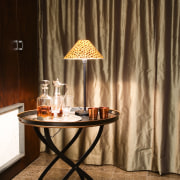Space for harmony
Sound furniture choices are based on taste as much as architectural style
Choosing furniture for your home can seem daunting, with shapes, colours, styles and textures to consider. But starting with a few basic principles can really pay off, says interior designer Leigh Caughey.
Broadly, she says, styles fall into classic, classic modern such as the room pictured here contemporary and French country. Caughey chooses furniture for her clients based on one of these styles, as well as the home's architecture and location, the dimensions of the rooms, and her client's lifestyle and tastes. Combining different styles in the same room is a popular option at the moment, she says, but it can be tricky.
"It can work very well, but you need to be clever to do it," she says. "You need the right pieces of furniture, and it helps if they're balanced in some way, perhaps with complementary textures or tones.

"I'd also suggest adding three items in one colour, or a tone of that colour, such as cushions and accessories, to tie everything together."
How does she choose furniture for rooms that are very large or small, or an unusual shape?
"For small spaces, L-shaped sofas work well, especially if they hug the walls, rather than a separate chair and sofa.
"Large spaces can be broken up into two spaces with a console or buffet, or made into separate seating areas if there's enough room. I'd also move furniture away from the walls to create a cosy space that people can relax in."
Long, narrow spaces are often the trickiest to furnish, Caughey says. She often divides them into two spaces, along a one-third, two-thirds ratio. The same ratio also works for other elements of a room, she says, such as colour choices for soft furnishings or cushions.
"If you're not sure about your furniture, or where to place it, it pays to talk to a professional even an hour's consultation can make a big difference," she says.
Story by: Trendsideas
Home kitchen bathroom commercial design
Diving into nature
Classic looks, contemporary efficiency
Personality plus






